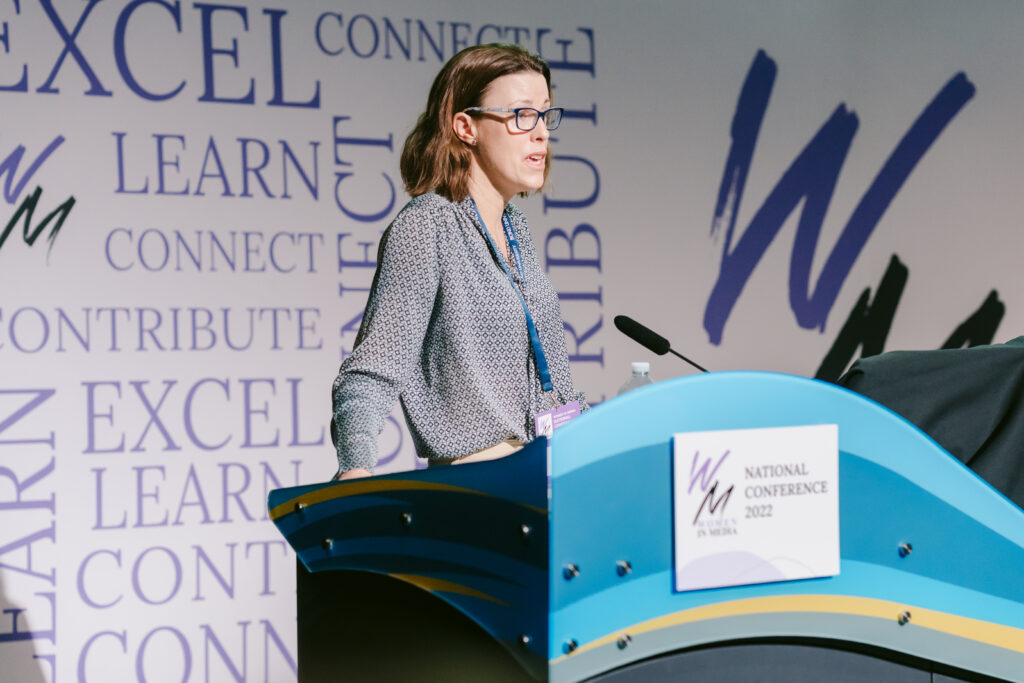This is a lightly edited speech given by journalism academic Dr Kathryn Shine at the recent Women in Media national conference on the Gold Coast.
I’m sure, like me, most of you have had the experience of a man speaking over you. Or you’ve been in a meeting where your male colleagues seemed to do all the talking. We know this happens in workplaces all the time. What you might not realise is that it’s also happening in news content.Every day, in news produced around the world, male voices and male perspectives dominate.
The Global Media Monitoring Report, which analyses news subjects in news media across more than 100 countries, found in 2020 that women made up just 26 per cent of sources in newspapers, 26 per cent of television news sources, 23 per cent of radio news sources and 28 per cent of online news sources.
Across Australian news media, women made up 32% of news sources, compared to men at 68%.
When you drill down into the GMMP data, you find that some cohorts of women are particularly marginalised in news content. Older women. Women of colour. Women with disabilities. And, when women do appear in the news, the reporting is often stereotypical and/ or sexist.

Kathryn Shine speaking at the WiM Conference. Picture: Supplied/Women in Media
Women are far more likely to provide ‘personal experience’ in a news story, than they are to be quoted for their expertise.
While we did see some improvements in Australia, overall, in the latest Global Media Monitoring Project, women were the main focus of just 6% of stories in traditional media and 9% in online news sites across news from around the world. According to the authors of the report, progress is ‘glacial’ and if we continue this way, it will take 67 years to close the gender gap in traditional media. The GMMP data aligns with Australian-specific research from the Women for Media Report 2021.
The analysis of 60,000 news articles published in May 2021 found that 31 per cent of quotes were attributed to women. Men were overrepresented in every category of news.
Why is this happening?
I’ve had people say to me: Of course, news is dominated by men. All the powerful people are men. Maybe that once was the case, but in 2022, that’s just not true. What’s more, journalism is not just about powerful people.
Another reason put to me, often by journalists themselves, is that women don’t want to be interviewed. Again, this is a simplistic response. My research suggests otherwise.
Journalism, historically, was produced by men. Women only started entering journalism in the 1950s and they were restricted to working on the women’s section. Newsroom history and culture is patriarchal.
Even though most journalism students are women and women comprise at least half of the journalism workforce in many developed countries including Australia, the UK and the US, most positions of news leadership are held by men. Editorial decision making is typically led by white, middle-aged men.
Why should we care?
I’m going to let leading UK researcher Professor Karen Ross answer that question: In 2007, she said: “Who is invited to speak as commentators on and in the news says crucially important things about who ‘counts’ in society, whose voices have legitimacy and status.”
The dominance of male voices and perspectives in the news normalises and reinforces ideas around male authority and superiority.
Let me pose a different question: Why should media companies care?
Because it affects their bottom line.Women are turning away from news in droves. Young women, in particular, are not engaging with the news. This is because they don’t see themselves in the coverage, or the issues that they care about.
If news bosses want to increase audiences, they must consider how to attract more women. Some media outlets are very aware of this and have been actively trying to drive change. The BBC started its 50:50 project in 2017 with the aim of achieving equal representation of women and men in content.
This has led to various positive impacts, including for example, that 58 per cent of women aged 16 to 34 surveyed said they visited the BBC news site more because of greater female representation in content. The project now involves 670 BBC teams and more than 100 partner organisations in 25 countries, including the ABC.
The ABC reported that it had achieved 50:50 in terms of news sources for the first time in March last year. So, change is possible.
But what we can do, as journalists, editors or media advisors, to actively encourage more women’s voices in the news?
This question has been the focus of my research in recent years. I started by interviewing women experts about their attitudes towards engaging with the news media, and their experiences of interacting with journalists. More recently, I’ve been working with the ABC’s 50: 50 team and researchers from the Global Institute for Women’s Leadership at ANU to survey a bigger group of women and men to try to identify what factors influence participation in the news, and what constitutes a positive and negative interview experience, from the perspective of the source.
We have just closed that survey and hope to start reporting the findings later this year, with the aim of establishing best practice in contemporary news interviewing.
In the meantime, let me tell you what I learnt from my interviews with women experts, and outline some advice and strategies to encourage more women, and others from under-represented groups, to have a say in the news. When I interviewed 30 female academic experts, across a range of disciplines and levels, I discovered:
All but one of them said they were willing to do media interviews. Almost all of them described their experiences of dealing with the media as ‘generally positive’. Yet almost all said they felt anxious or nervous about doing media interviews.
They felt a sense of obligation to promote their work and/or research, and this was the primary driver to do media interviews.
But, at the same time, they often lacked confidence and were concerned about seeming inarticulate or saying something inaccurate, being asked about something they didn’t know or offending people
Many were very reluctant to do on-camera interviews due to concerns about their appearance, as per this quote from a senior academic: “I’m just not very confident and I have a pretty low self-esteem. Stuff like that just makes me so incredibly nervous. Then I can’t actually display my technical knowledge or ability, because I just sit there thinking the whole time, ‘you should lose 20 kilos’. Oh, my God. You know what I mean? It sounds so stupid, but I’m 40 years-old and that stuff still plagues me.”
Timing/ lack of time were big issues. Many were highly self-critical of their interviews. Significantly, many said they did not understand how the media worked, or what journalists wanted from them. Most were wary about engaging with the media.
As one senior academic who works in a humanities faculty said:
“I think that we are more wary (than men), but in part, I think that’s just because we’re smart. Have a look at the way women are often portrayed in the media, particularly in Australia. I doubt it’s unreasonable for women to be quite wary.”
Based on my research, I have developed some recommendations for journalists and for sources.
Recommendations for journalists and editors:
- Negotiate: An interview request should not be a demand or a transaction. Be willing to be flexible. Find out what the barrier or concern is and try to address or resolve it. Maybe they just need 10 mins to prepare.
- Make a case: Tap into that sense of obligation. Most people want to promote their research/ work/cause and know that media interviews are an effective way to do so. Remind them of that.
- Be upfront and clear: Do you need a quick phone interview, or do you need an extended in-person conversation with photos and/or video? What exactly do you want to ask them about? Maybe provide a few questions in advance.
- Demystify the media: Don’t assume that your source knows you or even your media outlet. Take them through the process, step by step.
- Respect time constraints: Yes, journalists are time poor but so are the people they want to talk to.
- Offer to schedule a brief practice session and/or to give feedback after: People are often unsure about how they performed and whether they provided what the journalist was seeking, so feedback is sought-after and valued.
For prospective sources
- Say yes, BUT it does not have to be an unconditional yes. It’s perfectly OK to say, ‘give me 5 minutes to think about and I will call you back’. Or ‘yes, but I can only give you 10 minutes over the phone’.
- Ask questions. The journalist is not the only person who gets to ask questions. You have every right to ask questions to get a better sense of what they want, and the commitment required.
- Trust yourself. Invariably, if a journalist is seeking you out, that means you know your stuff. You don’t have to know absolutely everything.
- Cut yourself a break. It’s OK to stumble over words or say ‘Umm’. Everyone does. Consider every interview a chance to practise and learn from your mistakes.
- Be authentic. This is more important than anything else. The most polished media performer in the world can’t compete against someone who is passionate about their subject matter. Enjoy and appreciate the opportunity to talk about something you love, and the journalist and their audience will feel your enthusiasm come through.
On that note:
It is a privilege and a joy to speak to a group of women and feminists who care as much about media and equality as I do. I want to thank WIM, and in particular Vicki Laurie, for this wonderful opportunity. But I want to finish by saying:
This cannot be another inequality that women have to fix. Men have to get on board. It is not enough to be a passive supporter of equality.
So, talk to your male colleagues, talk to your male bosses, talk to your male students if you’re a teacher like me. Raise awareness about gender inequality in the news and share the responsibility for change.
For more, listen to Dr Shine discuss her research on The Experts Podcast.
Dr Kathryn Shine is a Senior Lecturer in Journalism at Curtin University. Dr Shine’s recent research has focused on the inclusion and portrayal of women in the news. She is the editor of the Western Independentand continues to work as a freelance journalist and moderator. She has previously worked as a journalist at news outlets includingThe Australian and The Sun Herald.





